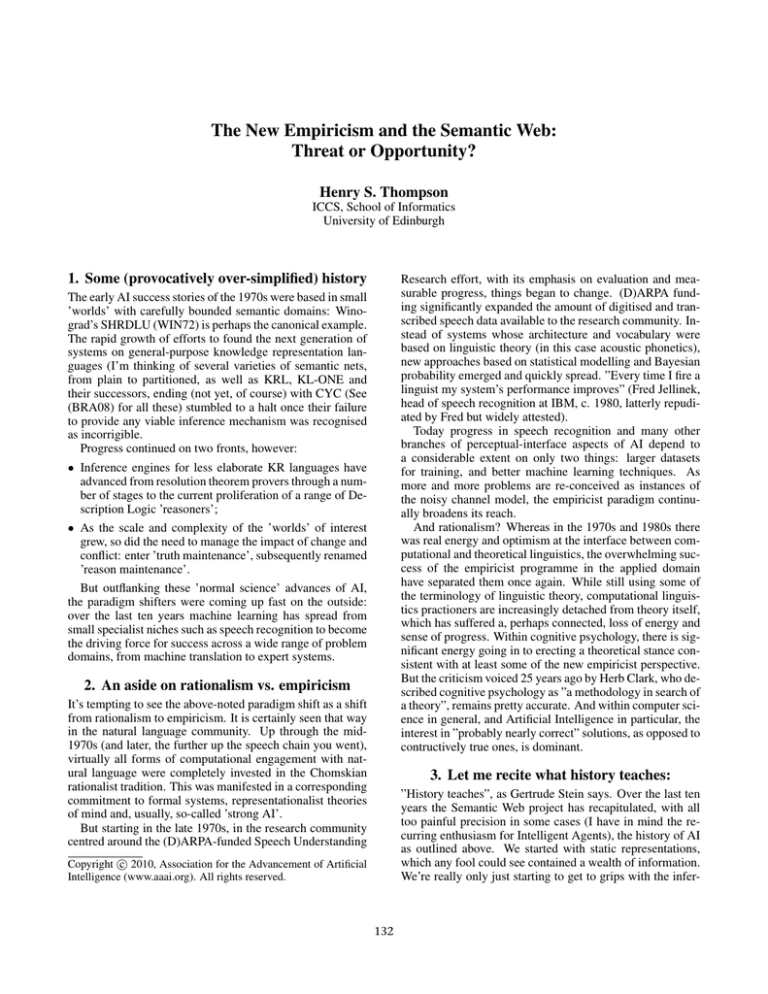
The New Empiricism and the Semantic Web:
Threat or Opportunity?
Henry S. Thompson
ICCS, School of Informatics
University of Edinburgh
1. Some (provocatively over-simplified) history
Research effort, with its emphasis on evaluation and measurable progress, things began to change. (D)ARPA funding significantly expanded the amount of digitised and transcribed speech data available to the research community. Instead of systems whose architecture and vocabulary were
based on linguistic theory (in this case acoustic phonetics),
new approaches based on statistical modelling and Bayesian
probability emerged and quickly spread. ”Every time I fire a
linguist my system’s performance improves” (Fred Jellinek,
head of speech recognition at IBM, c. 1980, latterly repudiated by Fred but widely attested).
Today progress in speech recognition and many other
branches of perceptual-interface aspects of AI depend to
a considerable extent on only two things: larger datasets
for training, and better machine learning techniques. As
more and more problems are re-conceived as instances of
the noisy channel model, the empiricist paradigm continually broadens its reach.
And rationalism? Whereas in the 1970s and 1980s there
was real energy and optimism at the interface between computational and theoretical linguistics, the overwhelming success of the empiricist programme in the applied domain
have separated them once again. While still using some of
the terminology of linguistic theory, computational linguistics practioners are increasingly detached from theory itself,
which has suffered a, perhaps connected, loss of energy and
sense of progress. Within cognitive psychology, there is significant energy going in to erecting a theoretical stance consistent with at least some of the new empiricist perspective.
But the criticism voiced 25 years ago by Herb Clark, who described cognitive psychology as ”a methodology in search of
a theory”, remains pretty accurate. And within computer science in general, and Artificial Intelligence in particular, the
interest in ”probably nearly correct” solutions, as opposed to
contructively true ones, is dominant.
The early AI success stories of the 1970s were based in small
’worlds’ with carefully bounded semantic domains: Winograd’s SHRDLU (WIN72) is perhaps the canonical example.
The rapid growth of efforts to found the next generation of
systems on general-purpose knowledge representation languages (I’m thinking of several varieties of semantic nets,
from plain to partitioned, as well as KRL, KL-ONE and
their successors, ending (not yet, of course) with CYC (See
(BRA08) for all these) stumbled to a halt once their failure
to provide any viable inference mechanism was recognised
as incorrigible.
Progress continued on two fronts, however:
• Inference engines for less elaborate KR languages have
advanced from resolution theorem provers through a number of stages to the current proliferation of a range of Description Logic ’reasoners’;
• As the scale and complexity of the ’worlds’ of interest
grew, so did the need to manage the impact of change and
conflict: enter ’truth maintenance’, subsequently renamed
’reason maintenance’.
But outflanking these ’normal science’ advances of AI,
the paradigm shifters were coming up fast on the outside:
over the last ten years machine learning has spread from
small specialist niches such as speech recognition to become
the driving force for success across a wide range of problem
domains, from machine translation to expert systems.
2. An aside on rationalism vs. empiricism
It’s tempting to see the above-noted paradigm shift as a shift
from rationalism to empiricism. It is certainly seen that way
in the natural language community. Up through the mid1970s (and later, the further up the speech chain you went),
virtually all forms of computational engagement with natural language were completely invested in the Chomskian
rationalist tradition. This was manifested in a corresponding
commitment to formal systems, representationalist theories
of mind and, usually, so-called ’strong AI’.
But starting in the late 1970s, in the research community
centred around the (D)ARPA-funded Speech Understanding
3. Let me recite what history teaches:
”History teaches”, as Gertrude Stein says. Over the last ten
years the Semantic Web project has recapitulated, with all
too painful precision in some cases (I have in mind the recurring enthusiasm for Intelligent Agents), the history of AI
as outlined above. We started with static representations,
which any fool could see contained a wealth of information.
We’re really only just starting to get to grips with the infer-
c 2010, Association for the Advancement of Artificial
Copyright Intelligence (www.aaai.org). All rights reserved.
132
ence problem, since it turns out that computers aren’t just
any fool, but particularly obdurate ones. Reason maintenance is . . ., well, yes, trust and provenance and attribution
are important, and we’ll need to tackle them Real Soon Now.
But machine learning? Almost not at all. The SemWeb
community still seems in the grip of good old-fashioned
logic-grounded AI: sentences represent states of affairs,
they are true or false, and inference engines which accurately reflect the relevant proof theory can tell us which.
The prospect of abandoning certainty in favour of probably
nearly is apparently abhorrent.
Winograd, Terry, Understanding Natural Language, 1972.
Academic Press, New York, NY.
4. Not a threat, an opportunity
Maybe the shift from talk about ’the Semantic Web’ to
talk about ’Open Data’ heralds the advent of the empiricist
hordes at, or even inside, the gates. But I don’t see much sign
of a change in attitude amongst the SemWeb ’old guard’.
I recently heard Web Science described, by an outsider, as
the empirical study of what actually happens on the Web:
the correlation between TLDs in search-result clickthrough
with time of day, for example. That’s empiricism alright, but
not obviously related to the matter at hand in any interesting
way. More to the point is the work of Halpin (HAL09) and
Fernandez (FERN09), treating aggregates of RDF triples as
grist for the machine learning mill in the context of state-ofthe-art information retrieval. The Statistical Semantic Web?
To exploit the reality of the kind of linked data which is actually rapidly appearing, i.e. data which is not consistent with
regard to ontology, these techniques are essential.
5. The end of the story?
A lot of value will come from statistically-based exploitation
of SemWeb data, I have no doubt. But that value will not
realise the original ”look Ma, no humans” Semantic Web
vision. The hard problems which have beset AI for the last
forty years are still largely unsolved. Although RDF’s use of
URIs distinguishes it from the historical KR languages, and
may yet provide real benefit, it seems implausible at best that
that difference alone will give us the breakthrough we need.
References
Brachman, Ron and B. C. Smith, eds, (1980). Why is
a Knowledge Representation System Like a Piano ACM
SIGART Bulletin Special Issue 70, Association for Computing Machinery, New York, NY, USA.
Fernandez, Miriam et al., ”Using TREC for crosscomparison between classic IR and ontology-based
search models at a Web scale”, 2009.
Presented
at Semantic Search 2009 Workshop, WWW2009,
Madrid, Spain. Available online as http://km.aifb.unikarlsruhe.de/ws/semsearch09/semse2009 18.pdf.
Halpin, Harry and Victor Lavrenko, ”Relevance Feedback
Between Hypertext and Semantic Search”, 2009. Presented at Semantic Search 2009 Workshop, WWW2009,
Madrid, Spain. Available online as http://km.aifb.unikarlsruhe.de/ws/semsearch09/semse2009 27.pdf.
133







